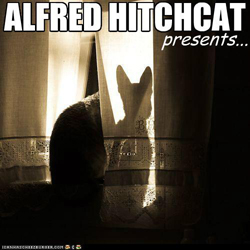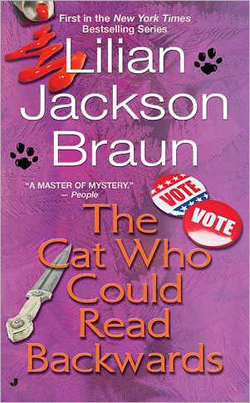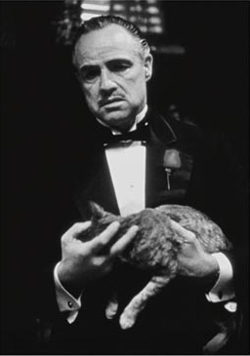
 Having said that, I will admit that the cat-mystery does impressive business. Feline-themed mysteries are an industry unto themselves. The Agatha Christie of the kitten-sleuth sub-genre was Lilian Jackson Braun. Anyone who’s perused the crime fiction aisle in the last thirty years can’t help but know about her Cat Who series. Braun was a rather mysterious figure in her own right. She published three Cat Who books in the sixties, disappeared for eighteen years, and then came back in 1986 and started releasing books at a pace to rival Robert B. Parker for clocklike regularity until her death in 2007. You don’t sell that many books unless you’ve hit some sort of sweet spot with a certain readership.
Having said that, I will admit that the cat-mystery does impressive business. Feline-themed mysteries are an industry unto themselves. The Agatha Christie of the kitten-sleuth sub-genre was Lilian Jackson Braun. Anyone who’s perused the crime fiction aisle in the last thirty years can’t help but know about her Cat Who series. Braun was a rather mysterious figure in her own right. She published three Cat Who books in the sixties, disappeared for eighteen years, and then came back in 1986 and started releasing books at a pace to rival Robert B. Parker for clocklike regularity until her death in 2007. You don’t sell that many books unless you’ve hit some sort of sweet spot with a certain readership.
But Braun was hardly alone. A partial list of cat-mystery writers includes Garrison Allen, Lorna Barrett, Rita Mae Brown, Carole Nelson Douglas, Sofie Kelly, Evan Marshall, Shirley Rousseau Murphy, and more. Many more.
On the basis of his letters to friends, we can determine that no less a hardboiled-heavyweight than Raymond Chandler was obsessed with cats. He once penned a note in the voice of his cat talking to another cat: “Come around sometime when your face is clean and we shall discuss the state of the world, the foolishness of humans, …the tenderloin side of a porterhouse, and our common difficulty in getting…meals served at more frequent intervals. I have got my staff up to five a day, but there is still room for improvement.”
I think we can all breath a sigh of relief that Chandler didn’t give Philip Marlowe a feline sidekick.
Cat-mysteries are so prevalent these days that some literary agents and crime fiction sites go out of their way to discourage submissions that feature the crime-solving pets. After all, a cat in the plot signals a gimmick, and a tired one at that. But I’m not here to slam these kinds of mysteries. Whatever floats your boat. Besides, when you have to tell would-be writers to stop writing mysteries about kittens, the kittens have already won.
But it does strike me as funny. Why mysteries about a particular pet? And why a cat? If you stop and think about it, a dog would make a more natural sleuth. After all, there are actual crime-fighting dogs in K-9 units all over the world. There are drug-sniffing dogs at airports. There are dogs trained to take down men with guns. Dogs have died in the line of duty and been given burials with honors. Dogs kick ass is what I’m saying here.
But dogs aren’t mysterious. They’re an open book. They love and hate in the open air. That’s their appeal. You know where you stand with a dog.
Cats, on the other hand, are mysterious little bastards. You have to give them that. They disappear for hours or days at a time. They like the night. (Hell, they have night-vision.) They stare at most humans with the same mix of condescension and malice.
The mysterious aura of cats made them a natural for crime films. For instance, a cat features in one of the quintessential scenes of film noir. After an hour of waiting for Orson Welles to arrive in The Third Man, viewers are tipped off to his presence by a cat who snuggles up to him in an alleyway as he spies on Joseph Cotten.
Or consider the role of the cat in John Huston’s masterpiece The Asphalt Jungle. Diner-owner James Whitmore says admiringly of a stray cat he’s feeding, “Smart cat. Never does a lick of work. Stays out all night, sleeps all day.” When a gruff truck driver snarls, “I run over one every time I get a chance” Whitmore tosses the guy out on his ear and tells him, “I ever see you runnin’ over a cat, I’ll kick your teeth out.” The scene establishes Whitmore as tough but ultimately soft hearted.
The most important cat appearance in film noir was in John Cromwell’s brilliant prison flick Caged. The occupants of a hard-scrabble women’s prison secretly adopt a kitten as a pet. When the cat is killed by one of the matrons, a riot breaks out. Here, the cat functions as a symbol of the last vestiges of femininely under assault in an unforgiving environment. While Caged is currently available on DVD as part of a Camp Classic collection, it’s not campy at all. It’s one of the great underrated film noirs, features a top-flight cast, gorgeous cinematography, and one of the most pitch-perfect endings in cinema. All that and a cute cat who dies a martyr’s death. For god’s sake, do not miss this film.

Or think of something like the subtle use of cats in the Coens’ No Country For Old Men. As Jim Emerson put it in a piece on the visual style of the film, “a cat drinking a puddle of spilled milk will provide all the visual information we need to know that there’s a corpse in a pool of blood behind a hotel counter.” Later in the film, as Tommy Lee Jones visits his mentor to discuss his dread about the world overrun with evil, he finds the man living in a hovel overrun with feral cats.
So cats are symbols of death and evil. Or they’re symbols of softness and femininity. Or maybe they’re not symbols at all. Maybe they’re just furry crimefighters. Take your pick. As for me, I have to go. Someone wants to be fed.
Jake Hinkson, The Night Editor

“Most of the time they are portents of doom”
There is always the story of the White House Ghost Cat that shows up around the time of a national diasaster/war/tragedy.
But in all seriousness, I would probably read The Adventures of
Sam Spayed and Kitty O’Shaughnessy, mostly because of the pun.
Great little essay on cats and crime. I liked it. I haven’t read any cat detective stories I’ve liked, so…maybe I’ll write one:)